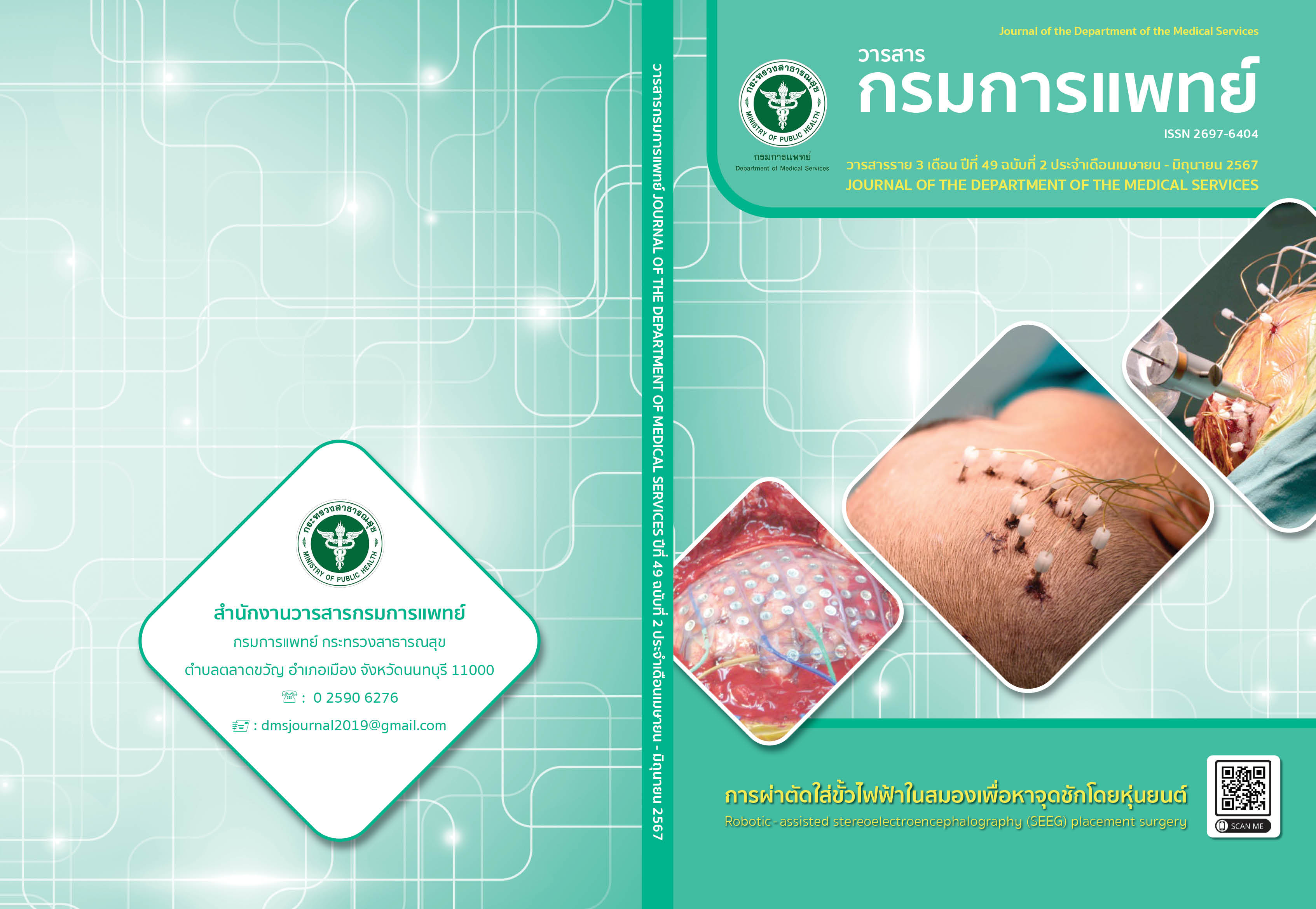The Comparison of Patient Clinical Outcomes between Antegrade and Retrograde Cannulation Methods Received Hemodialysis Machine Process at Arteriovenous Fistula
Keywords:
Arteriovenous fistula, Antegrade cannulation, Retrograde cannulationAbstract
Background: The arteriovenous fistula (AVF) is the most popular vascular access for hemodialysis (HD) procedures. Normally, it has two needle insertion methods at the arterial site, including the needle tip position has the parallel (antegrade) and the opposite (retrograde) directions to the arterial blood flow. However, the clinical outcomes of the patients receiving HD with both antegrade and retrograde cannulations need to be investigated. Objective: To compare the clinical outcomes of HD patients receiving between antegrade and retrograde cannulation methods. Method: We conducted a randomized crossover trial in HD patients with AVF. All patients were randomly assigned to either the antegrade (study) or the retrograde (control) group and then switched to the other group in the following HD session. Baseline patient characteristics, HD characteristics, the patient clinical outcomes (e.g., dialysis adequacy, clotting duration after needle removal, access recirculation, and pain scores) and staff satisfaction were collected. All data were presented in terms of number with its percentage or mean±standard deviation. We employed multivariable multilevel Gaussian regression to adjust prognostic variables. Result: A total of 246 HD sessions were included. The results showed no significant difference in any clinical outcomes. However, HD nurses significantly prefer antegrade to retrograde cannulation. Conclusion: HD nurse can design the needle position with either antegrade or retrograde cannulations depending on the patient’s condition and the suitable HD procedure without significant difference in patient clinical outcomes.
References
Nephrothai. Thailand renal replacement therapy year 2016 - 2019. [internet] 2021 [cited 2022 Apr 4].Available from: http//www.nephrothai.ory/wp-contentuploads/2021/01/1.TRT-Annual report-2016-2019.pdf.
Chayakul C, editors. Hemodialysis clinical practice recommendation 2014. Bangkok: Duentula; 2014.
Leelamali K. Hemodialysis Vascular Access.In: Iamong S, Praditpornsak H, Srisawat N, Tiranathanagul K,Tungsanga K, Praditpornsilpa K, editors. Hemodialysis renal replacement therapy. Bangkok: Tex & JournalPublishing Co. Ltd; 2013. p. 802 - 26.
Malovrh M. Native arteriovenous fistula: preoperative evaluation. Am J Kidney Dis 2002;39(6):1218 - 25.
Gauly A, Parisotto MT, Skinder A, Schoder V, Furlan A, Schuh E, et al. Vascular access cannulation inhemodialysis patients - a survey of current practice and its relation to dialysis dose. J Vasc Access2011;12(4):358 - 64.
Haage P, Vorwerk D, Wildberger JE, Piroth W, Schürmann K, Günther RW. Percutaneous treatment ofthrombosed primary arteriovenous hemodialysis access fistulae. Kidney Int 2000;57(3):1169 - 75.
Parisotto MT, Schoder VU, Miriunis C, Grassmann AH, Scatizzi LP, Kaufmann P, et al. Cannulation techniqueinfluences arteriovenous fistula and graft survival. Kidney Int 2014;86(4):790 - 7.
Ozmen S, Kadiroglu AK, Ozmen CA, Danis R, Sit D, Akin D, et al. Does the direction of arterial needle in AVfistula cannulation affect dialysis adequacy? Clin Nephrol 2008;70(3):229 - 32.
Oliver MJ, Dillavou ED, editors. Approach to the adult patient needing vascular access for chronichemodialysis. Canada: University of Toronto; 2023.
Reyes II OR. Effects of arterial needle placement in arteriovenous fistula on dialysis adequacy of end stagerenal disease patients undergoing maintenance hemodialysis. J Nur Healthcare 1;2016(2):10 - 1.
Verywell Health. Musselburgh: 11 Common Types of Pain Scales. [internet] 2022 [cited 2023 Apr 4].Available from: https://www.verywellhealth.com/pain - scales - assessment - tools - 4020329.
Lok CE, Huber TS, Lee T, Shenoy S, Yevzlin AS, Abreo K, et al. KDOQI clinical practice guideline for vascularaccess: 2019 Update. Am J Kidney Dis 2020;75(4 Suppl 2):S1 - S164.
Daryaprayong P, Uymanapong C. Permanent vascular access care in nursing practice recommendation forhemodialysis and peritoneal dialysis. Bangkok: Bangkok Medical Publishing; 2015. p.53 - 5.
Muraki R, Sathyanarayana D, Muthusethupathy MA. Assessment of quality of life in chronic kidneydisease patients using the kidney disease quality of life - short form questionnaire in Indian population:a community based study. Asian Journal of Pharmaceuticaland Clinical Research 2015;8(1):271 - 74.
Shrestha S, Ghotekar LR, Sharma SK, ShangwaPM, Karki P. Assessment of quality of life in patients of endstage renal disease on different modalities of treatment. JNMA J Nepal Med Assoc 2008;47(169):1 - 6.
Dias TS, Moysés Neto M, da Costa JA. Arteriovenous fistula puncture: an essential factor for hemodialysisefficiency. Ren Fail 2008;30(9):870 - 6.
National Kidney Foundation. KDOQI clinical practice guidelines and clinical practice recommendations for:Hemodialysis adequacy, peritoneal dialysis adequacy and vascular access: updates 2006. American Journalof Kidney Disease 2006;48(suppl1):S1 - 322.
Kang SM, Song WJ, Min KU. Comparison of recirculation and dialysis adequacy between antegrade andretrograde cannulation for hemodialysis. Clinical Nursing Research 2007;13:156 - 68.
Wiggins KJ, Agar JWM, Somerville CA. A controlled study of the impact of arterial needle direction ondialysis adequacy in patients undergoing hemodialysis through radiocephalic arteriovenous fistula.Nephrology 2003;8:A70.
Da Silva OM, Rigon E, Corradi Dalazen JV, Bissoloti A, Rabelo - Si va ER. During arteriovenous fistularcannulation in chronic renal patients on Hemodialysis. Open J Nurs 2016;6:1028 - 37.
Kaza BNK, Sabi KA, Amekoudi EYM, Imangue G, Badibanga J, Tsevi CM, et al. Pain during arteriovenousfistular (AVF) cannulation. American Journal of Internal Medicine 2014;2:87 - 9.
Figueiredo AE, Viegas A, Monteiro M, Poli - de - Figueiredo CE. Research into pain perception witharteriovenous fistula (avf) cannulation. J Ren Care 2008;34(4):169 - 72.
Kumar V, Depner T, Besarab A, Ananthakrishnan S. Arteriovenous Access for hemodialysis.In: Daugirdas JT,Blake PG and Ing TS, editors. Handbook of Dialysis. 4th ed. Philadelphia: Lippincott, Williams & Wilkins;2007. p.105 - 25.
Downloads
Published
How to Cite
Issue
Section
License
Copyright (c) 2024 Department of Medical Services, Ministry of Public Health

This work is licensed under a Creative Commons Attribution-NonCommercial-NoDerivatives 4.0 International License.
บทความที่ได้รับการตีพิมพ์เป็นลิขสิทธิ์ของกรมการแพทย์ กระทรวงสาธารณสุข
ข้อความและข้อคิดเห็นต่างๆ เป็นของผู้เขียนบทความ ไม่ใช่ความเห็นของกองบรรณาธิการหรือของวารสารกรมการแพทย์



